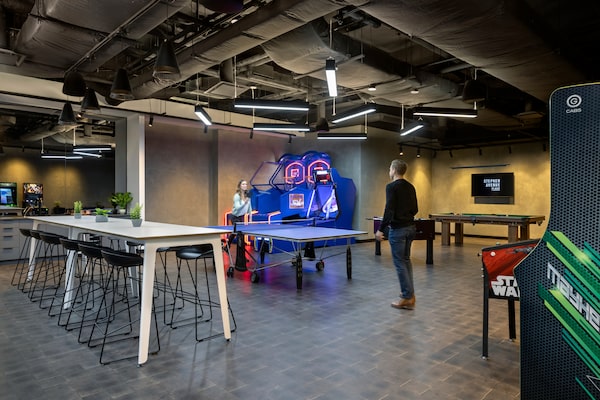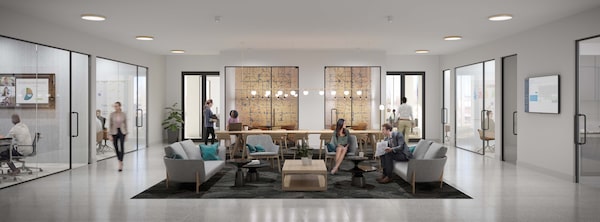
A rendering of Stephen Avenue Place in Calgary.Slate Asset Management/Supplied
In launching the redevelopment of a pair of office towers in Burnaby, B.C., Slate Asset Management is promoting added amenities, including a fitness centre and outdoor terraces between the two buildings, as attractions designed to entice employees back to the office.
With renovations set to begin in July, more than 10 per cent of the Capital Point complex at 4330 Kingsway Ave. in Burnaby’s Metrotown will be devoted to tenant amenities such as a double-height lobby in a shared podium at the base of the 10- and 19-storey buildings. Other additions will include a private courtyard with an outdoor kitchen, fitness centre, sun loungers for employees, bookable boardrooms and flexible meeting rooms.
The percentage of shared amenities will be even higher at another of the company’s redevelopments, Stephen Avenue Place, in Calgary. The mixed-use building is being renovated to include five restaurants – one will be a penthouse restaurant on the 40th floor of the building – a games room and lounge and a gym with locker rooms.
“These are things that tenants had been asking for even before the pandemic, but the pandemic has focused our thinking,” according to Brandon Donnelly, Toronto-based Slate’s managing director of development. “Companies that want to attract and retain top talent are going to have to offer great spaces and great amenities to bring people back to the office.”
“I think most people are sick of working at their kitchen table,” he adds, “but in a postpandemic world, workplaces will still have to be attractive alternatives, performing as social hubs with opportunities for collaboration and engagement while addressing employees’ needs for health and well-being.”
It’s a rethink that’s happening across the country in this era of home working. According to a December poll by public opinion firm Research Co., 80 per cent of Canadians who are currently working from home, instead of at their regular workplace, say they would like to continue to have the option after the COVID-19 pandemic has passed, an increase of 15 points from a similar survey done in April.

A lounge space at Stephen Avenue Place.Slate Asset Management/Supplied
But there’s also growing enthusiasm for resuming office life on a full-time basis, according to another survey by commercial real estate services firm JLL. Its Human Performance Report found that 80 per cent of high performers in technology, managers and professionals under the age of 35 say they have missed their office greatly during lockdown.
More than half of employees polled surveyed believe that an office environment is more conducive to team building and management support. The fall survey included input from professionals in 60 countries. It also found that 97 per cent of high performers miss the easy collaboration they enjoy in the office and 89 per cent consider their colleagues as a second family.
“Tenants are increasingly demanding more than the traditional office tower used to offer,” says Paris Lavan, JLL’s vice-president of office leasing in Vancouver. “Companies want their employees to be in buildings that support health, productivity, well-being and comfort. The focus has shifted to amenities – and high-end ones at that – traditionally seen more in hotels.”
“Almost everyone is talking about what will attract people back to offices,” says Janine Grossmann, principal and corporate interiors practice leader at Toronto-based architecture firm Perkins&Will. “We’re seeing a level of change that is quite phenomenal.”
Companies that had been waiting to see what happens, as working at home becomes the norm, are now committing to adding amenities associated with well-being that give employees facilities and options that they can’t get at home, she explains.
These are different from the dot.com-era foosball tables, video games and snacks and beer fridges that offices added to keep young people working long hours, she says. “It’s a lot more thoughtful. It’s not just about keeping a twentysomething there from eight in the morning until midnight, it’s [about recognizing] that work can happen anywhere at any time and offering features that help support their life.”

Stephen Avenue Place will include breakout spaces such as this.Slate Asset Management/Supplied
And the changes go far beyond just rearranging furniture. While clients, prepandemic, typically dedicated 3 per cent to 5 per cent to health and well-being amenities in an office redesign, it’s now anywhere between 10 per cent and 25 per cent, she adds.
“Spaces that support employees’ physical health are a bigger part of the equation, as people have been unable to go to gyms and don’t have equipment at home,” adds Danielle Leon, associate principal and design lead at Perkins&Will.
While the company can’t talk about projects for specific clients, walking tracks around the perimeter of offices, fitness equipment, yoga rooms and shower rooms are making their way into workplace designs, Ms. Leon says.
One client is providing staff with outdoor Wi-Fi and a 20-minute walking path they can follow to have an active meeting. Instead of a sick room or lounge, another trend is to develop small break rooms for people to use in different ways, with the options of music and adjustable lighting.
“Whether it’s to meditate or get more excited, people can find space and technology that supports what they would not be able to do at home,” Ms. Leon says.
Expanded healthy food and beverage options are also part of office redesign discussions, she adds.

More than 10 per cent of the Capital Point complex at 4330 Kingsway Ave. in Burnaby, B.C., will be devoted to tenant amenities.Slate Asset Management/Supplied
“In a future in which more people have the choice to work from home, the question is ‘what will the office bring to your life?’ It may be that the office will become a respite,” Ms. Leon suggests. “If my house is crazy, the office can become a quiet place where no one is going to bother me for a couple of hours, where I can focus and get my work done.”
“To attract the top talent in a postpandemic world, the office will be a differentiator. You are going to have to offer great spaces and amenities to bring people back,” Mr. Donnelly says.
He doesn’t expect there will be a trend toward dramatically smaller offices in the future. “We expect that even if there are fewer employees in the office, the square footage per employee will come up a bit, so the space needs will be about equal,” he says.
Physical offices will remain critical in ensuring organizational success, he says, because a company’s office space is an important part of its corporate culture.
“A collaborative office space can foster a sense of inclusion and inspire innovation,” he adds. “When we look ahead to our postpandemic world, we believe adaptable, flexible, high-quality office space will continue to be in high demand.”